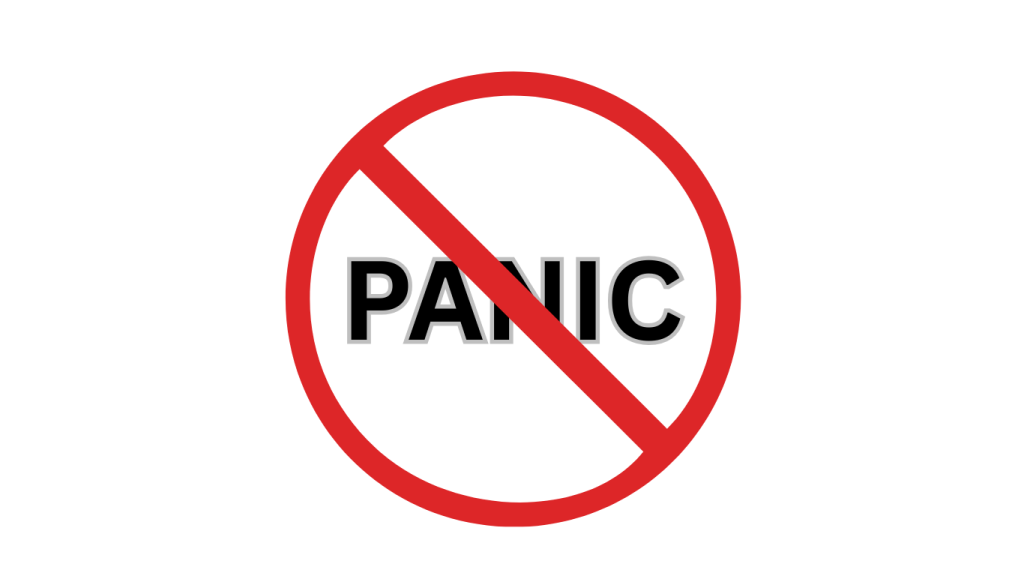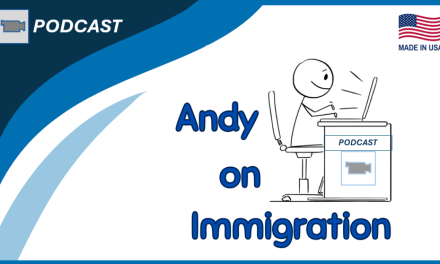May 21, 2025
Summary: Start with wellness. Address items you can control. Seek organizational readiness.
The Big Picture: Uncertainty
The first 100 days of the Trump Administration has brought a feeling of uncertainty for many. DOGE caused nervousness for government employees and programs heavily dependent upon government funding. Tariffs unnerved markets, consumers, and businesses dependent upon global trade. While markets have seemingly recovered from initial shocks, recent pullbacks on tariffs still leave analysts conflicted as to the direction of the broader economy over the next 12 months.
When it comes to immigration, there has been a flurry of Executive Orders and actions that certainly have been unnerving to immigrants, as well as many travelling across borders. Foreign national employees may be feeling the stress and concerns about cross-border travel can impair them from carrying out international activities, or taking vacations, outside the U.S. Cutbacks at USCIS and at consulates abroad may cause even slower processing times for employer-sponsored visas and green cards, but for now no major changes to core categories have occurred. In large part, employers seem to have been spared from major direct impacts, though many may be on high alert for enforcement actions and increased scrutiny of sponsorship petitions, waiting for the other shoe to drop.
Will there be a more direct hit on employers beyond the impact of employers in certain industries where undocumented persons more commonly work? Will a recession hit and force reconsideration of foreign national sponsorship? Will access to H-1B workers be more limited? Do the best and brightest still want to come to the U.S.? Should employers plan to move operations and/or workers outside the U.S., capitalizing on offers like that from French President Emmanuel Macron to woo scientists?
“The primary measure of a successful human resources function is organizational readiness.” With that in mind, let’s review a platform for necessary immigration planning employers should be considering for the next 12 months, despite the continuing uncertainty.
Step One: Executive-Level Readiness Starts with Clarity and Wellness
According to OSHA, 83% of US workers suffer from work-related stress and 54% of workers report that work stress affects their home life. The American Psychological Association (APA) reports that 92% of U.S. workers said it is very (52%) or somewhat (40%) important to them to work for an organization that provides support for employee mental health. If your job involves responsibility for immigration functions, I suspect you can be counted among the “very stressed.”
Under such conditions, wellness has become a central theme to Andy on Immigration content. My recommendations to US employers worrying about immigration: before firing off another “What if ICE raids us tomorrow?” email, block out 10 minutes for a true reset. Take a break from contemplating what might go wrong for your foreign national employees. Enforce “no-email” hours, limit weekend work but moreover think about something else. A frazzled staff delivers panic; a firm that prioritizes wellness delivers strategy. In short, amidst heightened immigration stress, you must put on your own oxygen mask first before you can render support to others.

Put Your own Oxygen Mask on First!
Step 2: Assess Your Organizational Risk Profile Honestly
Many legal advisors have been warning you about all the prep work you should be doing to prepare for audits and on-site enforcement actions. Don’t panic! Remember that certain industries and locations face various levels of scrutiny — stay calm, assess your situation, and know where you stand.
- Labor-Intensive Operations: Agriculture, food processing, hospitality, landscaping, construction, and cleaning firms have traditionally been higher-visibility targets for immigration raids.
- ICE’s Enforcement Hotspots:
- Based on a review of ICE’s website, many notable ICE enforcement actions appear directed at individuals and in large part do not occur at worksites. However, there are some enforcement actions that have occurred at worksites (like this one in South Dakota or another at a construction site near Ocala, FL), though they may be more focused on individuals in these particular raids rather than employers. Nevertheless, these are disruptions to employers’ businesses.
- Immigration & Customs Enforcement (“ICE”) conducted no-notice I-9 inspections in Washington, DC, serving 100+ Notices of Inspection on May 6 including several on restaurants.
- For employers of foreign nationals, USCIS may also make site visits to assess compliance with immigration sponsorship rules, for example H-1B or L-1 workers. In the past, USCIS has noted a greater likelihood of violations among employers with less than 25 employees or $10 million in revenues.
Action Step: Review your vulnerabilities for I-9 audits or worksite visits. Based on your risk profile (industry, whether you sponsor foreign nationals, etc.) prioritize your efforts to ensure compliance and prepare for an impromptu site visit or enforcement action. This isn’t a deep audit—just a realistic snapshot of where you’re most exposed.
Step 3: Everyone Prepare; If You’re at Higher Risk, Don’t Panic
I would never encourage anyone not to prepare, but I do I want to remind employers that while surprise ICE visits can be “splashy”, newsworthy events, the odds of an in-person visit are still relatively low. Nevertheless, and particularly if your company profile is high-risk, you cannot afford to be caught flat-footed.
- Pay attention to the details in the news to stay aware of your risk level. Many of the news stories of immigration enforcement involve individual undocumented persons being taken into custody at locations unrelated to their place of work. If there is an all-out, multi-agency raid at a worksite, the focus may be more on the employees but clearly can be disruptive to employers or lead to a deeper inquiry.
- As noted above, delivery of an I-9 Notice of Inspection seems more likely at present than an outright raid directed at the employer.
- Know your rights: Review with counsel what ICE or USCIS can and cannot do—warrants, scope of inspection, employee interviews, document review.
- Designate a response team: Identify who handles law-enforcement inquiries, who alerts counsel, and who manages internal communications. Script your “when-they-knock” playbook.
- Revisit I-9, H-1B, and immigration compliance overall. Before heading to a full self-audit, check that current (and recent) procedures are functioning properly, as this might be a good indicator of your exposure. If this quick-check reveals problems, or if your company is high risk (for example, by industry), then a more extensive self-audit might be appropriate.
As with all of the points listed here, this is not a replacement for legal advice, nor should you consider such educated guesses on risk level as gospel – they are simply broad assessments based on experience and current reporting which you might consider in your risk assessment.
Step 4: Support Your Foreign-National Workforce Proactively
Anxiety over enforcement can hammer productivity and morale. Show your people you’ve got their backs. Consult with legal counsel as needed to provide general guidance and recommendations, which might include:
- Daily “status verification kits”: what documents should employees carry with them to document their legal status and work authorization when at their jobsite.
- Travel briefings: If staff travel across borders for work, equip them with a packet of general instructions, status verification kits, and 24/7 contact numbers.
- Wellness channels: Launch peer-support groups or lunchtime Q&As with HR and immigration counsel. Remind everyone that mental-health benefits and Employee Assistance Programs exist—and are there to help.
Step 5: Contingency Planning for Sponsorship & Mobility
If you are an employer that sponsors foreign nationals, there are items to consider beyond checking your compliance with the H-1B program. One should also consider that issues with petition processing, visa processing delays, petition denials, or sudden rule changes are the new normal—Plan B is not optional.
- Create a contingency playbook: For example, what if a worker’s extension petition is denied?
- Backup staffing plans, for example if you have many H-1B workers on staff: For each key role, map alternative options: premium processing, change of status, or consider temporary remote work via third-country hubs (using EOR (Employer-of-Record) or digital-nomad visas).
- Cost-benefit conversations: Be ready to explain trade-offs: “Yes, a nomad-visa route adds X dollars in overhead, but it keeps this critical function running when U.S. processing stalls or the worker becomes unavailable.”
- Future-state staffing: should you plan for a workforce abroad? Is the current tenor of U.S. immigration policy likely to hinder future hiring of foreign nationals? The demand for H-1Bs is already well beyond availability (about one-third of registrations were accepted for continued processing this year), so should you study a broader plan for hiring workers who can live and work in countries other than the United States?
Step 6: Plan for Economic Shocks with Immigration in Mind
A recession or layoff wave may disproportionately affect visa holders. While there is uncertainty as to whether a recession will occur this year and what the corresponding impact will be on job loss, there are enough signs suggesting that employers should be prepared for such actions. In fact, there have already been job cuts announced in 2025 among several employers, including Intel, UPS, and Microsoft. So, how should employers of foreign nationals prepare?
- Grace-period awareness: Plan for grace periods, if any, for visa holders who lose their jobs. Discuss with counsel whether maintaining personnel on payroll can keep them “in status” longer.
- Clear layoff protocols: Communicate early and provide immigration-aware transition support—severance plus relocation assistance or referrals to counsel or pro bono legal clinics. Coordinate with labor/employment counsel.
- Consider the impact of layoffs on H-1B sponsorship (especially H-1B dependent employers) and green card sponsorship (especially via labor certification), and whether to suspend such sponsorship even if layoffs are not a certainty for your company.
Step 7: Revisit Your Legal Partnerships
In these uncertain times, it is imperative to have not just knowledgeable immigration counsel, but also counsel that is proactive, responsive, and understands your company’s business and specific needs. This will put your company in the best position to respond to whatever comes your way and hopefully reduce your individual stress.
- First, make sure you have immigration counsel ready to go. This should not be your corporate counsel or general employment counsel, but counsel specializing in immigration. Get referrals, talk to your colleagues at other companies, or visit AILA.org for lists of counsel.
- Demand Strategic Deliverables: Ask for scenario-planning memos, “reentry kits,” and a quarterly policy snapshot—beyond just invoices.
- Global Coordination: If your company sponsors foreign nationals, ensure that your provider can connect you with vetted partners for digital-nomad visas or third-country work arrangements should employing workers abroad become necessary or desired.
- Rapid-Response Guarantees: Build SLAs (service-level agreements) into your retainer or flat-fee arrangements so you’re not left waiting when minutes matter.
- Reconsider your fee agreement. For example, don’t overpay for RFEs. Requests for Evidence can run the gamut from simple address confirmation to explaining from the origins of time to the present how the offered job and position meet the standards for H-1B status. If you have a flat fee for RFEs, make sure to distinguish between simple versus complex or switch to hourly rates with an agreed-to maximum. Ask your counsel to consider committing to flat fee or fixed ranges/caps for other types of services not previously contemplated in your original agreement.

Reach Out if You Need a Helping Hand
Step 8: Put Your Wellness First, Reach out for Help
Doing nothing is not an option—but panic is worse. The next 12 months will reward employers who combine clearheaded leadership, genuine care for their people, and flexible, creative strategies. You can’t control every policy headline, but you can control how your company shows up, how you maintain compliance, protect your workforce, and how you safeguard your operations. Above all, put your own oxygen mask on first!
If you want expert, non-legal assistance from someone with business, immigration, and consulting experience to help in reviewing your situation, for example selecting counsel or managing fee arrangements with outside counsel, please reach out to me at andy@andyonimmigration.com.







